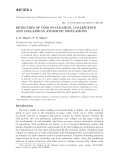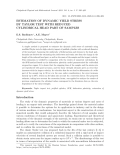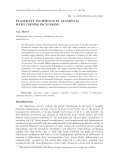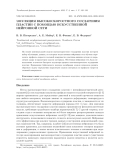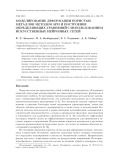Extraction of required information from atomic configurations is crucial for efficient use of molecular dynamics (MD) simulations, and automating this process allows the collection of statistical data to develop and validate physical models and data-driven approaches. Here we update the previously developed pore searching algorithm to automatically detect the events of void nucleation, collapse and coalescence by comparing pairs of atomic configurations. We calculate an intersection matrix, which shows common regions between voids of current and previous time frames, and analysis of this intersection matrix gives a numerical criterion for determination of the considered events. The updated algorithm is verified in the case of small MD system and further used to analyze a large MD system with many hundreds of voids. The predominance of void collapse is confirmed in the case of uniform triaxial tension of solid aluminum, while void coalescence instead of collapse is detected in the case of a more complex loading with axial compression and lateral tension. This dependence of the predominant mechanism on the loading path correlates with previous finite element analysis in the literature. Another interesting finding is a continuing nucleation and collapse of voids far beyond the fracture beginning at a level of negative pressure much lower than the spall strength, which can be attributed to a developed defect structure of material produced by plastic growth of voids.
A simple method is proposed to estimate the dynamic yield stress of materials using modified Taylor tests for high-velocity impact of profiled cylinders with a reduced diameter of the head part. Assuming the uniformity of deformations and stresses in the head part, formulas are derived for estimating the yield stress and strain rate from the change in the length of the reduced head part, as well as the mass of the sample and the impact velocity. This estimation is verified by comparison with the results of numerical calculations by the SPH method based on the dislocation plasticity model parameterized for cold-rolled oxygen-free copper. It is shown that the stopping time of the sample and the strain rate are reproduced with good accuracy, and the shear strength estimate gives an error that increases with the impact velocity. At velocities that do not lead to deformation of a wide part of the sample (up to 90 m/s in the case under consideration), the error increases linearly up to 30%, which can be taken into account by a correction factor. The proposed estimate, taking into account the correction factor, was applied to analyze the results of previous experiments; the obtained values correspond to the literature data on the rate dependence of the shear strength.
The dislocation activity controls the plastic deformation in the most of metallic materials. Mechanical loading with high strain rates or with high strain gradients can lead to either homogeneous nucleation of the dislocation or emission of dislocations from various heterogeneities, such as nanopores and phase precipitates. The dislocation nucleation and emission trigger plasticity, which relaxes the shear component of stresses. In this work, we study the threshold of dislocation emission from nanosized copper inclusions in an aluminum single crystal in comparison with the homogeneous nucleation of dislocations in pure metal. We consider different shapes of inclusions (spherical, cylindrical and cubic) and rather arbitrary axisymmetric deformations by means of molecular dynamics (MD) simulations. For most deformation paths, the copper inclusions substantially reduce the threshold of plasticity incipience, while the inclusions have no effect for some deformation paths with either axial or transverse extension. Depending on the deformation path, the shape of inclusion can either influence the emission threshold or not. Thus, there is a complex dependence of the threshold of plasticity incipience on the deformation path, the presence and the form of copper inclusions. This dependence is approximated by means of an artificial neural network (ANN) trained on the results of MD simulations. The trained ANN can be further applied as a constitutive equation at the level of continuum mechanics.
На основе континуальной модели высокоскоростного соударения пластин построен набор обучающих данных, по которым искусственная нейронная сеть обучена определять профиль скорости тыльной поверхности пластины-мишени исходя из параметров удара и параметров модели материала. Обученная нейронная сеть была использована в качестве быстрого эмулятора процесса высокоскоростного соударения пластин. Применение байесовского подхода калибровки модели позволило решить обратную задачу определения параметров модели материала по профилю скорости тыльной поверхности.
На основе базы данных, полученной с помощью модели высокоскоростного соударения пластин, связывающей параметры удара и параметры модели материала с профилем скорости тыльной поверхности, проведено сравнение процесса обучения и точности искусственной нейронной сети прямого распространения и рекурсивной нейронной сети. Рекурсивная нейронная сеть обеспечивает б´ольшую точность и требует меньшего времени для обучения. Использование рекурсивной нейронной сети в качестве быстрого эмулятора модели и байесовская калибровка могут позволить решить обратную задачу определения параметров модели вещества по профилю скорости тыльной поверхности с большей точностью.
Исследование направлено на разработку макроскопической континуальной модели динамической деформации пористых металлов на основе применения искусственных нейронных сетей. Для обучения ИНС используются наборы данных, полученные моделированием сжатия представительных объёмов пористой среды методом гидродинамики сглаженных частиц на основе ранее параметризованной для меди модели дислокационной пластичности. Такое моделирование применяется как для набора обучающих данных, так и для исследования физики деформации пористой меди с порами микрометрового и миллиметрового масштаба.
